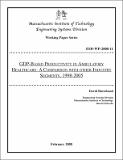GDP-Based Productivity in Ambulatory Healthcare: A Comparison with other Industry Segments, 1998-2005
Author(s)
Hartzband, David
Downloadesd-wp-2008-11.pdf (426.3Kb)
Metadata
Show full item recordAbstract
Few studies have focused on productivity in healthcare, let alone in ambulatory healthcare. Measurement of productivity in various healthcare segments has generally shown that productivity has either decreased (over some time period) or has increased more slowly than in other industry segments. This study shows that labor productivity has increased in ambulatory healthcare between 1998 and 2005 (by ~24%), but that capital efficiency has not changed over that time period. The study compared this result with the same measurements in the auto and information industry segments (as defined by the Bureau of Economic Analysis) and found that labor productivity gains were highest in the information industry (34%) and lowest in auto (6%), and that capital efficiency increased 8% in the information industry but decreased 7% in auto.
The study also found a strong linkage between changes in gross domestic product components for value-added and gross output and both labor and capital inputs in ambulatory healthcare. This linkage was not found in either of the other two industry segments investigated. This linkage implies that labor and capital input account for close to all of the productivity gains measured in ambulatory healthcare, but that other factors, such as labor quality, work process and structural reorganization, research and development investment and adoption of new technologies are not affecting this gain in productivity the way they may be in auto and the information industry. This result implies that addressing these factors may increase productivity in ambulatory healthcare even more than has been the case from labor and capital input increases.
Date issued
2008-02Publisher
Massachusetts Institute of Technology. Engineering Systems Division
Series/Report no.
ESD Working Papers;ESD-WP-2008-11